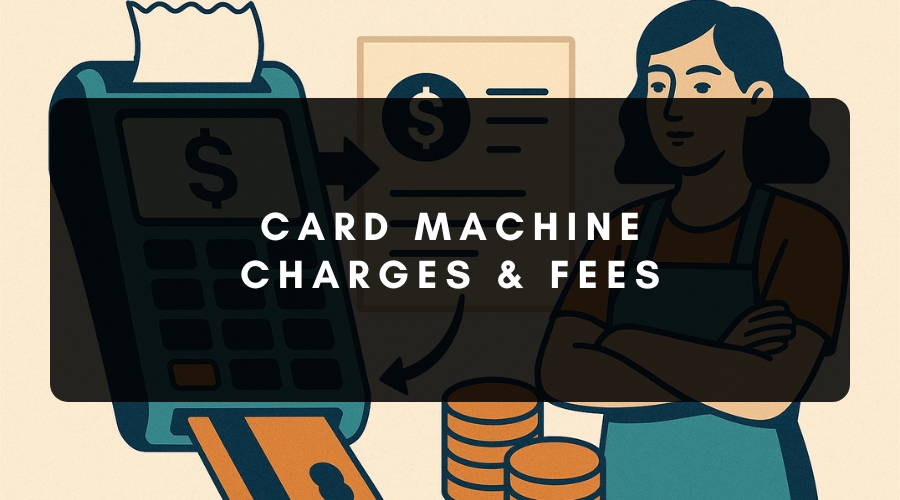
Card Machine Charges & Fees
Accepting card payments using a physical terminal, virtual terminal, or online payment gateway has evolved from an optional extra to a customer expectation throughout Europe, making card machine charges part and parcel of doing business. However, it’s possible to pay too much for this service or miss out on essential features that could help you increase your revenue by partnering with the wrong provider.
Familiarity with standard card machine fees and credit card processing fees, and how to optimise these costs, will help you remain competitive and maximise your return on investment. So, which card machine charges and fees should you expect, and how can you ensure the best result?
1. Hardware Costs and Alternatives
The card machine hardware itself is the first expense most merchants incur when implementing card acceptance. These days, “hardware” refers to more than just countertop terminals. It also refers to contemporary devices like tablets and mPOS units.
Business owners typically have the following hardware options:
- Purchasing a terminal outright: This is a single purchase of a mobile, portable, or countertop device. Advanced models with touchscreens or built-in receipt printers cost over €700, while basic models start at about €150. This option is ideal for businesses with a large transaction volume where the initial investment will be recouped gradually.
- Leasing or renting: Rental terminals are available from some payment processors for €15 to €40 a month. Although this lowers upfront expenses, it ends up costing more than a direct purchase for businesses over time. Be mindful of unstated fees for setup, cancellation, and additional accessories (like a contactless reader or PIN pad).
- mPOS units: mPOS card readers (which we offer as part of our financial platform) are tiny card readers that link to a tablet or smartphone, enabling you to accept payments anywhere. They are perfect for pop-up shops, events, delivery services, and small businesses.
- Standalone mPOS terminals: There are also standalone mPOS models available (at a cost of up to €250 if purchasing outright) that have their own screens and SIM slots, and are Wi-Fi enabled.
Virtual terminals provide a digital alternative: Virtual terminal payment processing offers an entirely digital solution that eliminates the need for a physical machine by enabling you to enter client card information into a secure web page. This is particularly helpful for phone orders or remote payments. However, because of the increased risk of fraud, fees are higher because keyed-in transactions are classified as “card-not-present.”
2. Transaction Fees
A transaction fee is paid each time a credit or debit card payment is accepted. For retailers, this is frequently the biggest expense. The transaction fee includes:
- The interchange fees charged by issuing banks and established by card networks (such as Visa and Mastercard). In Europe, the Interchange Fee Regulation (IFR) was established in 2015 to make these fees more affordable for merchants. However, there is still debate about how effective this move has been in lowering interchange costs in practice.
- The assessment fee charged by the card network.
- The markup charged by your merchant services provider.
Depending on your pricing model, card type, and location, transaction fees for card payments generally range from 0.5 per cent to 3 per cent per transaction.
Understanding the Role of Credit Card Networks and Issuers
There are multiple parties involved when you accept card payments:
- The cardholder (your client or customer)
- The vendor or merchant (you)
- The acquiring bank (the bank that processes card payments on your behalf)
- The company that handles payments (your service provider)
- The card network (Mastercard, Visa, etc.)
- The card issuing bank (the bank that issued the customer’s credit card)
A tiny portion of the fee is split between the parties. While assessments are charged by the card network and your processor adds a markup, interchange fees are paid to the card issuer. Familiarity with this flow will help you better understand the breakdown of costs.
3. Monthly Fees and Statement Fees
Many credit card processors charge monthly fees in addition to transaction fees. These consist of:
- Monthly service fees: Monthly service fees cover PCI (Payment Card Industry) compliance, account maintenance, and customer service.
- Statement fees: Statement fees consist of a nominal fee for either digital or printed transaction reports, typically ranging from €5 to €15 per month.
- Payment gateway fees: You may pay an additional fee for the use of the provider’s payment gateway if you also take online payments.
Some payment processing companies bundle everything into a slightly higher per-transaction rate with no fixed cost rather than charging separate monthly fees. This will be less expensive for small businesses with lower turnover. It also provides predictability for easier budgeting.
4. Setup Fees and Additional Costs
There is a setup fee when installing a card machine. These fees are frequently negotiable or waived in promotional offers. Other additional costs to be aware of:
- Transactions involving manual entry: Because there is a greater chance of fraud, you will be charged more when you enter a customer’s card number manually rather than swiping or inserting a physical card.
- Batch or settlement fees: A tiny fee is usually charged by payment processors each time you settle the transactions from the day.
5. PCI Compliance Fees
Merchants must abide by the Payment Card Industry (PCI) Data Security Standard to protect cardholder data. A standard PCI compliance fee usually costs between €5 and €20 per month. In exchange, your payment processor will assist you in maintaining compliance.
Make sure your provider offers you helpful advice or tools to help you stay on track, because non-compliance will result in fines that are far more costly to your business than PCI fees.
6. Chargeback Fees and Fraud Risks
A chargeback occurs when a customer contests a transaction, and the money is returned. In addition to the loss of the initial transaction amount if you are unable to demonstrate that the chargeback was fraudulent, the merchant must cover the financial institution’s processing cost, which is $9.08 to $10.32 per instance on average, according to 2025 data from Mastercard.
For an additional monthly fee, certain credit card processing companies provide chargeback protection. This is helpful for maintaining your account’s good standing and preventing unexpected costs.
7. Pricing Models Explained
The primary price structures that you will come across are:
- Flat-rate pricing: All card payments incur the same fixed percentage.
- Interchange-plus pricing: Interchange-plus pricing includes a fixed markup from the payment processor in addition to the actual card network interchange fee. This model is transparent and often more economical for large retailers, although fees are unpredictable.
- Tiered pricing: Transactions are bundled into “tiers” by risk level. This pricing model often conceals higher fees and works out less favourably for merchants.
The most obvious choices for the majority of small businesses are interchange-plus and flat-rate. You can request a comprehensive rate breakdown from your merchant services provider to understand what is and isn’t included.
8. Hidden Fees to Watch Out For
Even trustworthy credit card processors charge minor fees that are easy to overlook. Keep an eye out for:
- Early termination fees that are charged if you decide to end your contract
- Fees for next-day funding for quicker deposits
- Replacement costs for terminals that are lost or damaged
- Fees associated with accepting cards from countries outside the European Economic Area
To identify any unforeseen charges, carefully go over your merchant agreement and review your monthly statements when they arrive.
How to Save Money on Card Machine Fees
You will reduce card machine and credit card processing fees as a business owner by taking these accessible actions:
- Negotiate with your provider: Rates can often be negotiated, particularly if you handle large transaction volumes.
- Promote the use of debit cards: Processing fees for debit and credit cards differ. Because there is less risk to the bank when processing debit card payments than when processing credit card payments, interchange rates are lower.
- Process batch transactions once a day: Batch your transactions and process them once a day to avoid paying several batch fees.
- Maintain PCI compliance: Keep your checkout secure to prevent expensive penalties for non-compliance.
- Examine and compare payment processors: Prices differ greatly, and some payment processors provide features like customisable fraud prevention tools or better customer service that end up saving you money, time, and headaches.
FAQs About Card Machine Charges & Fees
Q1: How much does it typically cost to accept card payments in Europe?
A: In Europe, the typical fee for taking credit or debit cards ranges from 0.5 per cent to 3 per cent per transaction.
Q2: What are interchange fees?
A: Interchange fees are imposed by card networks; they are limited to 0.2 per cent for debit card transactions and 0.3 per cent for credit card transactions.
Q3: What distinguishes interchange-plus pricing from flat pricing?
A: Interchange-plus pricing consists of the precise cost of each transaction with a markup, whereas flat-rate pricing is more predictable but provides less information about the breakdown of each transaction.
Q4: Are there any unstated costs?
A: Yes, there are unstated costs. Keep an eye out for early termination, refund, statement, PCI, and monthly fees.
Q5: Do I have to rent or purchase a card machine?
A: You can buy a terminal outright for long-term savings, rent one for flexibility, or opt for a low-cost mPOS device if you process in-person payments on the go.
Q6: What is a virtual terminal for?
A: A virtual terminal (an online tool) allows you to manually enter card information for mail order, telephone, or remote payments.
Q7: Can I charge customers for my card processing costs?
A: It’s prohibited to pass on card fees to consumers in Europe. While cash discounts are sometimes acceptable, direct surcharges are not allowed.
Q8: What do chargeback fees entail?
A: Chargeback fees are expenses associated with handling disputes, plus the cost of goods or services delivered in some cases.
Q9: How can I reduce the cost of my card machine?
A: You can reduce the costs associated with your card machine by promoting the use of debit cards, minimising manual entry, and comparing providers.
Q10: Do I have to comply with PCI?
A: PCI compliance is necessary; non-compliance will cost you far more in the form of losses and penalties resulting from data breaches and payment fraud.
Optimise Fees With the Right Payment Service Provider
Selecting a merchant service provider is just as crucial as the actual card reader. Seek out:
- Clear pricing structures (interchange-plus or flat-rate)
- Excellent customer service and prompt resolution of problems
- Supports all of the major card networks (Visa, Mastercard, etc.)
- Transparent reporting tools and statement fees
- Adherence to PCI DSS, the Payment Card Industry Data Security Standard
Additionally, think about whether you require a single provider for both online and in-person payments. In order to streamline accounting and cut costs, many payment processing companies provide bundled packages for virtual terminals, card machines, and e-commerce payment gateways. The most favourable package will help you increase your earnings while avoiding unnecessary costs.

